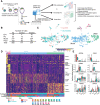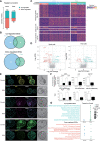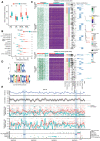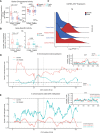Single-cell multi-omics of human preimplantation embryos shows susceptibility to glucocorticoids
- PMID: 35948369
- PMCID: PMC9528977
- DOI: 10.1101/gr.276665.122
Single-cell multi-omics of human preimplantation embryos shows susceptibility to glucocorticoids
Abstract
The preconceptual, intrauterine, and early life environments can have a profound and long-lasting impact on the developmental trajectories and health outcomes of the offspring. Given the relatively low success rates of assisted reproductive technologies (ART; ∼25%), additives and adjuvants, such as glucocorticoids, are used to improve the success rate. Considering the dynamic developmental events that occur during this window, these exposures may alter blastocyst formation at a molecular level, and as such, affect not only the viability of the embryo and the ability of the blastocyst to implant, but also the developmental trajectory of the first three cell lineages, ultimately influencing the physiology of the embryo. In this study, we present a comprehensive single-cell transcriptome, methylome, and small RNA atlas in the day 7 human embryo. We show that, despite no change in morphology and developmental features, preimplantation glucocorticoid exposure reprograms the molecular profile of the trophectoderm (TE) lineage, and these changes are associated with an altered metabolic and inflammatory response. Our data also suggest that glucocorticoids can precociously mature the TE sublineages, supported by the presence of extravillous trophoblast markers in the polar sublineage and presence of X Chromosome dosage compensation. Further, we have elucidated that epigenetic regulation-DNA methylation and microRNAs (miRNAs)-likely underlies the transcriptional changes observed. This study suggests that exposures to exogenous compounds during preimplantation may unintentionally reprogram the human embryo, possibly leading to suboptimal development and longer-term health outcomes.
© 2022 Zhao et al.; Published by Cold Spring Harbor Laboratory Press.
Figures





Similar articles
-
Single-cell multi-omics sequencing reveals chromosome copy number inconsistency between trophectoderm and inner cell mass in human reconstituted embryos after spindle transfer.Hum Reprod. 2023 Nov 2;38(11):2137-2153. doi: 10.1093/humrep/dead186. Hum Reprod. 2023. PMID: 37766497
-
TEAD4 regulates trophectoderm differentiation upstream of CDX2 in a GATA3-independent manner in the human preimplantation embryo.Hum Reprod. 2022 Jul 30;37(8):1760-1773. doi: 10.1093/humrep/deac138. Hum Reprod. 2022. PMID: 35700449
-
Treatment with AICAR inhibits blastocyst development, trophectoderm differentiation and tight junction formation and function in mice.Mol Hum Reprod. 2017 Nov 1;23(11):771-785. doi: 10.1093/molehr/gax050. Mol Hum Reprod. 2017. PMID: 28962017 Free PMC article.
-
The contribution of human sperm proteins to the development and epigenome of the preimplantation embryo.Hum Reprod Update. 2018 Sep 1;24(5):535-555. doi: 10.1093/humupd/dmy017. Hum Reprod Update. 2018. PMID: 29800303 Review.
-
DNA methylation dynamics during epigenetic reprogramming in the germline and preimplantation embryos.Genes Dev. 2014 Apr 15;28(8):812-28. doi: 10.1101/gad.234294.113. Genes Dev. 2014. PMID: 24736841 Free PMC article. Review.
Cited by
-
Omics Views of Mechanisms for Cell Fate Determination in Early Mammalian Development.Genomics Proteomics Bioinformatics. 2023 Oct;21(5):950-961. doi: 10.1016/j.gpb.2023.03.001. Epub 2023 Apr 17. Genomics Proteomics Bioinformatics. 2023. PMID: 37075831 Free PMC article. Review.
-
Manual Dissociation of Mammalian Preimplantation Embryos for Single-Cell Genomics.Methods Mol Biol. 2024;2767:293-305. doi: 10.1007/7651_2023_494. Methods Mol Biol. 2024. PMID: 37418145
-
Maternal preconception stress produces sex-specific effects at the maternal:fetal interface to impact offspring development and phenotypic outcomes†.Biol Reprod. 2024 Feb 10;110(2):339-354. doi: 10.1093/biolre/ioad156. Biol Reprod. 2024. PMID: 37971364 Free PMC article.
-
An atlas of small non-coding RNAs in human preimplantation development.Nat Commun. 2024 Oct 5;15(1):8634. doi: 10.1038/s41467-024-52943-w. Nat Commun. 2024. PMID: 39367016 Free PMC article.
-
Changing the public perception of human embryology.Nat Cell Biol. 2023 Dec;25(12):1717-1719. doi: 10.1038/s41556-023-01289-4. Nat Cell Biol. 2023. PMID: 37985870 No abstract available.
References
MeSH terms
Substances
LinkOut - more resources
Full Text Sources
Medical
